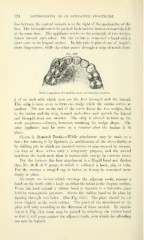Page 726 - My FlipBook
P. 726
724 ORTHODONTIA AS AN OPERATIVE PROCEDURE.
line between the central incisors is to the riglit of the niechan hnc of the
face. The bicuspids are to be pushed back and the incisors toward the left
at tiie same time. The appliance works on the principle of two wedges
drawn toward each other. On the canine is cemented a band with a
short tube on its lingual surface. In this tube is placed one of Angle's
short drag-screws, while the other passes through a strip of metal about
Writer's appliance for making room and drawing cuspid in.
\ of an inch wide which rests on the first bicuspid and the lateral.
This strip is bent so as to form one wedge while the canine serves as
another. The nut on the end of the screw draws the two wedges, that
is, the canine and the strip, toward each other and spreads the lateral
and bicuspid from one another. The strip is altered in form as the
work progresses—always, however, retaining its wedge shape. The
same appliance may be worn as a retainer after the canine is in
place.
Class 3. Rotated Teeth.—\Yhile attachment may be made to a
tooth for rotating it by ligatures (a modification of the clove hitch) or
by drilling pits in which are inserted screws or pins secured by cement,
the first of these serves only a temporary purpose, and the second
mutilates the tooth more than is warrantable except in extreme cases.
For the incisors the best attachment is a Magill band not thicker
than No. 36 B. & S. gauge, to which is soldered a hook, pin, or tube.
For the canines a swaged cap is better, as it may be cemented more
firmly in place.
To rotate an incisor which overlaps the adjacent tooth, cement a
band on the tooth with a hook on either the labial or the lingual surface.
From this hook extend a rubber band or ligature to a vulcanite plate
held by atmospheric pressure. Secure the rubber band to the plate by
ligating through two holes. (See Fig. 665.) The plate should be cut
away slightly as the tooth rotates. The point of the attachment to the
plate will vary according to the direction of force needed. By attach-
ing at C, Fig. 712, room may be gained by attaching the rubber band
so that it will press against the adjacent tooth, over which the otfending
one may be lapped.


